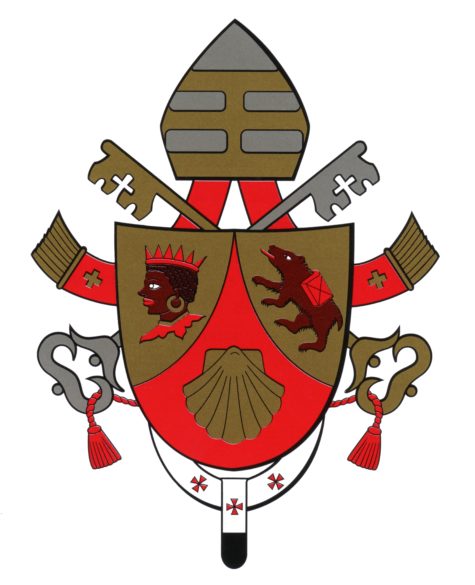By Msgr. Andrea Cordero Lanza di Montezemolo
VATICAN – The shield chosen by Pope Benedict XVI is very simple: it is in the shape of a chalice.
In each of the upper corners there is a “chape” in gold. The “chape” [cape] is a symbol of religion. It indicates an idealism inspired by monastic or, more specifically, Benedictine spirituality.
The principal field of the coat of arms is the central one which is red. At the point of honor of the shield is a large gold shell that has a triple symbolism.

Its first meaning is theological. It is intended to recall a legend attributed to St. Augustine. Meeting a child on the beach who was trying to scoop up the sea into a hole in the sand, Augustine asked him what he was doing. The child explained his vain attempt and Augustine took it to refer to his own futile endeavour to encompass the infinity of God within the confines of the limited human mind.
The scallop shell, moreover, has been used for centuries to distinguish pilgrims.
Benedict XVI wanted to keep this symbolism alive, treading in the footsteps of John Paul II. The design of large shells that decorated the chasuble he wore at the solemn liturgy for the beginning of his Pontificate, Sunday, April 24, was most evident.
The scallop is also an emblem that features in the coat of arms of the ancient Monastery of Schotten near Regensburg (Ratisbon) in Bavaria, to which Joseph Ratzinger felt spiritually closely bound.
In the corner is a Moor’s head, the ancient emblem of the Diocese of Freising, founded in the eighth century, which became a Metropolitan Archdiocese with the name of München und Freising in 1818, subsequent to the Concordat between Pius VII and King Maximilian Joseph of Bavaria (June 5, 1817).
A brown bear is portrayed in the other corner of the shield, with a pack-saddle on its back. An ancient tradition tells that the first Bishop of Freising, St. Corbinian, set out for Rome on horseback. While riding through a forest he was attacked by a bear that tore his horse to pieces. Corbinian managed to tame the bear and make it carry his baggage. This explains why the bear is shown carrying a pack.
The shield carries the symbols connected to the person who displays it, to his ideals, traditions, programmes of life and the principles that inspire and guide him. The various symbols of rank, dignity and jurisdiction of the individual appear instead around the shield.
It has been a venerable tradition for the Supreme Pontiff to surround his shield with crossed keys, one gold and the other silver, in the form of a St. Andrew’s cross: these have been variously interpreted as symbols of spiritual and temporal power.
Matthew’s Gospel recounts that Christ said to Peter: “I will entrust to you the keys of the kingdom of heaven. Whatever you declare bound on earth shall be bound in heaven; whatever you declare loosed on earth shall be loosed in heaven” (Mt 16:19). The keys are therefore the typical symbol of the power that Christ gave to St. Peter and his Successors.
The Papal mitre shown in his arms, is silver and bears three bands of gold (the three powers: Orders, Jurisdiction and Magisterium), joined at the centre to show their unity in the same person.
There is also a completely new symbol in the arms of Pope Benedict XVI: the “pallium.” It is not part of the tradition, at least in recent years, for the Supreme Pontiffs to include it in their arms. It stands for the Pope’s responsibility as Pastor of the flock entrusted to him by Christ.
In general, it is customary to place a ribbon or cartouche below the shield, bearing a motto or a heraldic device. It expresses in a few words an ideal or a programme of life.
In his Episcopal arms, Cardinal Joseph Ratzinger had chosen the motto “Cooperatores Veritatis.” This remains his aspiration or personal programme but does not appear in his Papal arms, in accordance with the tradition common to the Supreme Pontiffs’ arms in recent centuries.
Pope St. John Paul II would often quote his motto, “Totus Tuus,” although it did not feature in his Papal arms. The absence of a motto in the arms implies openness to all ideals that may derive from faith, hope and charity.
Read the full description of his Coat of Arms on the Vatican’s website: https://bit.ly/PopeBenedictCoatofArms.
